maintenance mode Acura TLX 2017 Owner's Guide
[x] Cancel search | Manufacturer: ACURA, Model Year: 2017, Model line: TLX, Model: Acura TLX 2017Pages: 75, PDF Size: 10.99 MB
Page 10 of 75
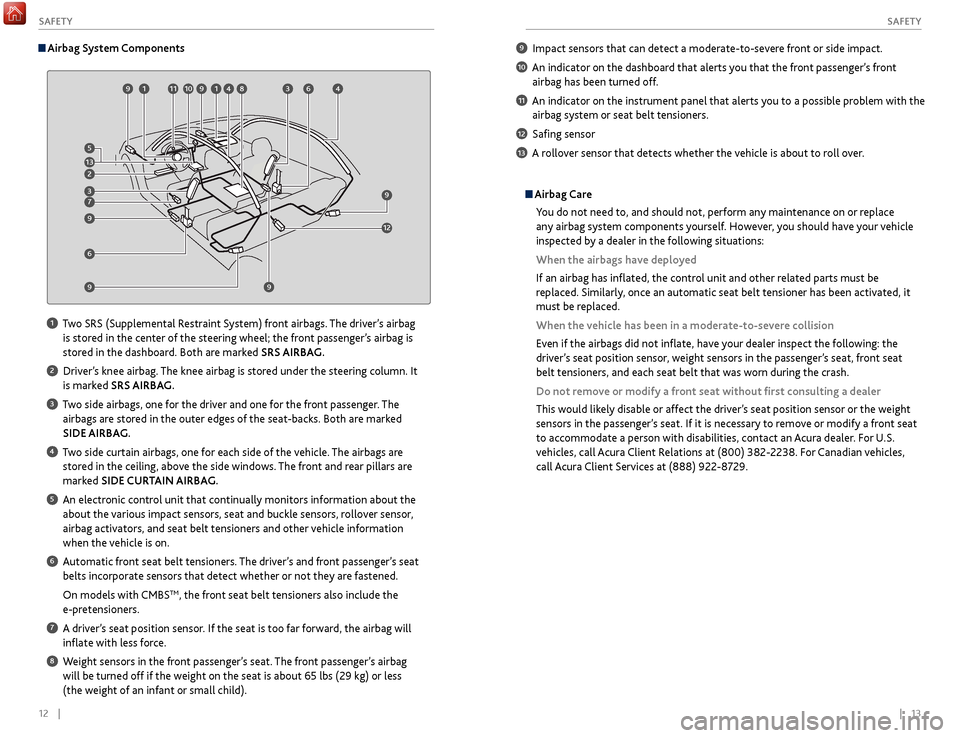
12 || 13
S AFETY
S
AFETY
Airbag System Components
1 Two SRS (Supplemental Restraint System) front airbags. The driver’s airbag
is stored in the center of the steering wheel; the front passenger’s airbag is
stored in the dashboard. Both are marked SRS AIRBAG.
2 Driver’s knee airbag. The knee airbag is stored under the steering column. It is marked SRS AIRBAG.
3 Two side airbags, one for the driver and one for the front passenger. The airbags are stored in the outer edges of the seat-backs. Both are marked
SIDE AIRBAG.
4 Two side curtain airbags, one for each side of the vehicle. The airbags are stored in the ceiling, above the side windows. The front and rear pillars are
marked SIDE CURTAIN AIRBAG.
5 An electronic control unit that continually monitors information about the about the various impact sensors, seat and buckle sensors, rollover sensor,
airbag activators, and seat belt tensioners and other vehicle information
when the vehicle is on.
6 Automatic front seat belt tensioners. The driver’s and front passenger’s seat belts incorporate sensors that detect whether or not they are fastened.
On
models with CMBS
TM, the front seat belt tensioners also include the
e-pretensioners.
7 A driver’s seat position sensor. If the seat is too far forward, the airbag will inflate with less force.
8 Weight sensors in the front passenger’s seat. The front passenger’s airbag will be turned off if the weight on the seat is about 65 lbs (29 kg) or less
(the weight of an infant or small child).
Airbag Care
You do not need to, and should not, perform any maintenance on or replace
any airbag system components yourself. However, you should have your vehicle
inspected by a dealer in the following situations:
When the airbags have deployed
If an airbag has inflated, the control unit and other related parts must be
replaced. Similarly, once an automatic seat belt tensioner has been activated, it
must be replaced.
When the vehicle has been in a moderate-to-severe collision
Even if the airbags did not inflate, have your dealer inspect the following: the
driver’s seat position sensor, weight sensors in the passenger’s seat, front seat
belt tensioners, and each seat belt that was worn during the crash.
Do not remove or modify a front seat without first consulting a dealer
This would likely disable or affect the driver’s seat position sensor or the weight
sensors in the passenger’s seat. If it is necessary to remove or modify a front seat
to accommodate a person with disabilities, contact an Acura dealer. For U.S.
vehicles, call Acura Client Relations at (800) 382-2238. For Canadian vehicles,
call Acura Client Services at (888) 922-8729.
99 99
911 9194 98 93 94
96
91 910
9129
9
9
9
99 9
6 9
9
9
7
93 9
2
913 9
5
9 Impact sensors that can detect a moderate-to-severe front or side impact.
10 An indicator on the dashboard that alerts you that the front passenger’s front
airbag has been turned off.
11 An indicator on the instrument panel that alerts you to a possible problem with the airbag system or seat belt tensioners.
12 Safing sensor
13 A rollover sensor that detects whether the vehicle is about to roll over.
Page 61 of 75
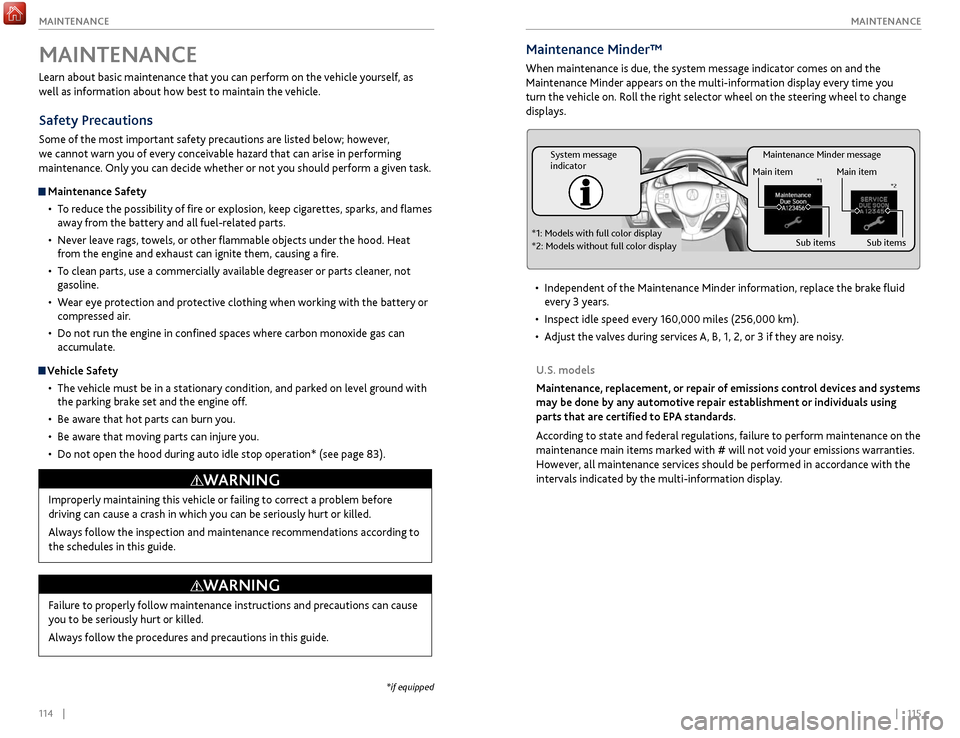
114 || 115
MAINTENANCE
MAINTENANCE
Maintenance Minder message
System message
indicator
Main item
Sub items
Main item
Sub item s*1
*2
*1: Models with full color display
*2: Models without full color display
Maintenance Minder™
When maintenance is due, the system message indicator comes on and the
Maintenance Minder appears on the multi-information display every time you
turn the vehicle on. Roll the right selector wheel on the steering wheel to change
displays.
•
Independent
of the Maintenance Minder information, replace the brake fluid
every 3 years.
•
Inspect idle speed ev
ery 160,000 miles (256,000 km).
•
A
djust the valves during services A, B, 1, 2, or 3 if they are noisy.
U.S. models
Maintenance, replacement, or repair of emissions control devices and systems
may be done by any automotive repair establishment or individuals using
parts that are certified to EPA standards.
According to state and federal regulations, failure to perform maintenance on the
maintenance main items marked with # will not void your emissions warranties.
However, all maintenance services should be performed in accordance with the
intervals indicated by the multi-information display.
Learn about basic maintenance that you can perform on the vehicle yourself, as
well as information about how best to maintain the vehicle.
Safety Precautions
Some of the most important safety precautions are listed below; however,
we cannot warn you of every conceivable hazard that can arise in performing
maintenance. Only you can decide whether or not you should perform a given task.
Maintenance Safety
•
T
o reduce the possibility of fire or explosion, keep cigarettes, sparks, and flames
away from the battery and all fuel-related parts.
•
Nev
er leave rags, towels, or other flammable objects under the hood. Heat
from the engine and exhaust can ignite them, causing a fire.
•
T
o clean parts, use a commercially available degreaser or parts cleaner, not
gasoline.
•
W
ear eye protection and protective clothing when working with the battery or
compressed air.
•
Do not run
the engine in confined spaces where carbon monoxide gas can
accumulate.
Vehicle Safety
•
The
vehicle must be in a stationary condition, and parked on level ground with
the parking brake set and the engine off.
•
Be awar
e that hot parts can burn you.
•
Be awar
e that moving parts can injure you.
•
Do not
open the hood during auto idle stop operation* (see page 83).
MAINTENANCE
Improperly maintaining this vehicle or failing to correct a problem before
driving can cause a crash in which you can be seriously hurt or killed.
Always follow the inspection and maintenance recommendations according to
the schedules in this guide.
WARNING
Failure to properly follow maintenance instructions and precautions can cause
you to be seriously hurt or killed.
Always follow the procedures and precautions in this guide.
WARNING
*if equipped
Page 62 of 75
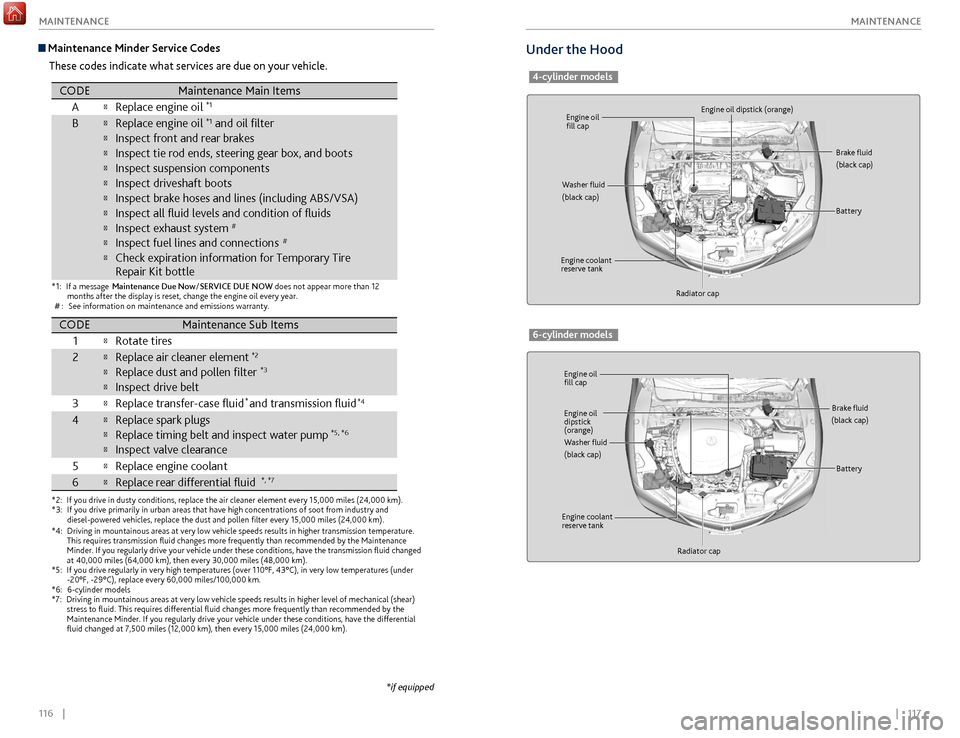
116 || 117
MAINTENANCE
MAINTENANCE
Under the Hood
4-cylinder models
Engine oil
fill cap
Engine oil
fill cap Engine oil dipstick (orange)
Engine oil
dipstick
(orange)
Washer fluid
(black cap)
Washer fluid
(black cap) Brake fluid
(black cap)
Brake fluid
(black cap)
Engine coolant
reserve tank
Engine coolant
reserve tank Radiator cap
Radiator cap Battery
Battery
6-cylinder models
Maintenance Minder Service Codes
These codes indicate what services are due on your vehicle.
*1:If a message Maintenance Due No w/SERVICE DUE NOW does not appear more than 12
months after the display is reset, change the engine oil every year.
#: See information on maintenance and emissions warranty.
*2:If you drive in dusty conditions, replace the air cleaner element every 1\
5,000 miles (24,000 km).*3:If you drive primarily in urban areas that have high concentrations of so\
ot from industry and
diesel-powered vehicles, replace the dust and pollen �lter every 15,0\
00 miles (24,000 km).
CODEMaintenance Main Items
A�Replace engine oi l*1
B�Replace engine oil*1 and oil �lter
�Inspect front and rear brakes
�Inspect tie rod ends, steering gear box, and boot s
�Inspect suspension components
�Inspect driveshaft boots
�Inspect brake hoses and lines (including ABS/VSA)
�Inspect all �uid levels and condition of �uids
�Inspect exhaust system#
�Inspect fuel lines and connections#
�Check expiration information for Temporary Tire
Repair Kit bottle
*4:Driving in mountainous areas at very low vehicle speeds results in highe\
r transmission temperature.
This requires transmission �uid changes more frequently than recommen\
ded by the Maintenance
Minder. If you regularly drive your vehicle under these conditions, have the transmission �uid
changed at 40,000 miles (64,000 km), then every 30,000 miles (48,000 km).*5:If you drive regularly in very high temperatures (over 110°F, 43°\
C), in very low temperatures (under -20°F, -29°C), replace every 60,000 miles/100,000 km.
*6:6-cylinder models*7:Driving in mountainous areas at very low vehicle speeds results in highe\
r level of mechanical (shear) stress to �uid. This requires differential �uid changes more frequ\
ently than recommended by the
Maintenance Minder. If you regularly drive your vehicle under these cond\
itions, have the differential
�uid changed at 7,500 miles (12,000 km), then every 15,000 miles (\
24,000 km).
CODEMaintenance Sub Item s
1
�Rotate tires
2�Replace air cleaner element*2
�Replace dust and pollen �lter*3
�Inspect drive belt
3
�Replace transfer-case �uid and transmission �uid*4
4�Replace spark plugs
�Replace timing belt and inspect water pump*5, *6
�Inspect valve clearance
5
�Replace engine coolan t
6�Replace rear differential �ui d*, *7
*
*if equipped
Page 63 of 75

118 || 119
MAINTENANCE
MAINTENANCE
Engine Oil
Park the vehicle on level ground, and wait approximately three minutes after
turning the engine off before you check the oil.
Checking the Oil
1.
Open
the hood (see page 118). Remove the
dipstick (orange loop).
2.
Wipe
the dipstick with a clean cloth or paper
towel.
3.
Insert
the dipstick all the way back into its hole.
4.
R
emove the dipstick again, and check the level. It
should be between the upper and lower marks.
Add oil if necessary.
Recommended Engine Oil
•
Genuine A
cura Motor Oil
•
Pr
emium-grade 0W-20 detergent oil with an API Certification Seal on the
container
This seal indicates the oil is energy conserving and
that it meets the American Petroleum Institute’s
latest requirements.
Use Genuine Acura Motor Oil or another
commercial engine oil of suitable viscosity for the
ambient temperature as shown.
You may also use synthetic motor oil if it is
labeled with the API Certification Seal and is of the
specified viscosity grade.
4-cylinder models
6-cylinder models
4-cylinder models6-cylinder models
Upper
Lower Upper
Lower
Ambient temperature
Opening the Hood
1.
P
ark the vehicle on a level surface, and apply
the electric parking brake.
2.
Pull
the hood release handle under the lower
left corner of the dashboard.
3.
Slide
the hood latch lever in the center of the
hood to release the lock mechanism, and then
open the hood.
4.
Lift the
hood up most of the way. The
hydraulic supports lift it up the rest of the way
and hold it up.
When closing the hood, lower it to
approximately 12 inches (30 cm), then press
firmly down with your hands.
Do not open the hood when the wiper arms are raised. The hood will strike the
wipers, and may damage either the hood or the wipers.
Do not open the hood during auto idle stop operation* (see page 83).
NOTICE
Pull
Lever
*if equipped
Page 64 of 75
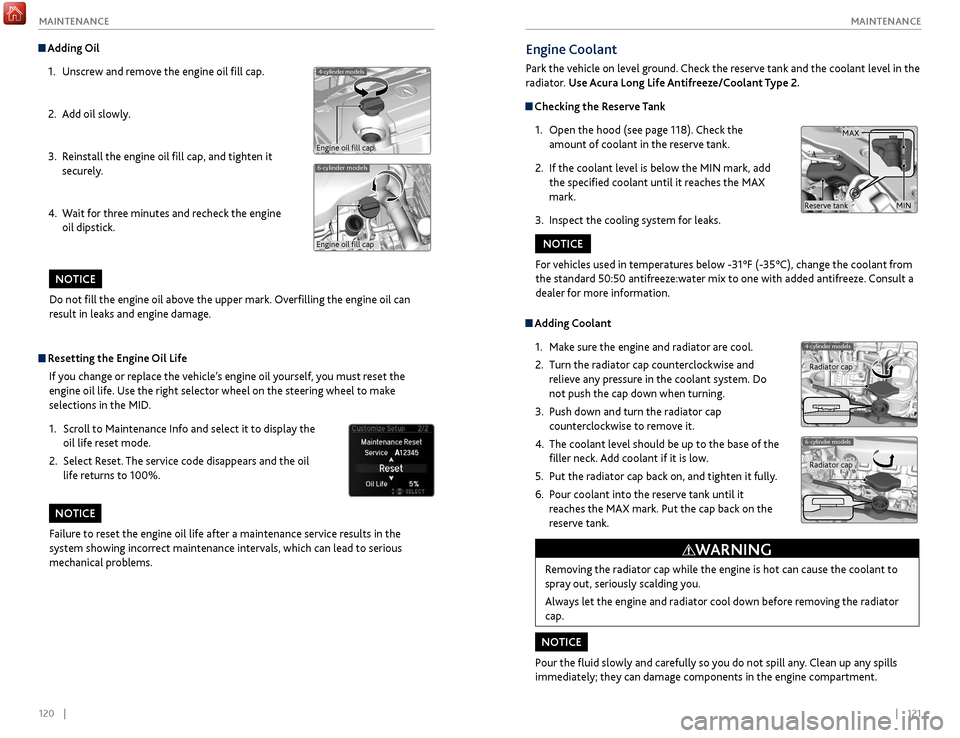
120 || 121
MAINTENANCE
MAINTENANCE
Engine Coolant
Park the vehicle on level ground. Check the reserve tank and the coolant level in the
radiator. Use Acura Long Life Antifreeze/Coolant Type 2.
Checking the Reserve Tank
1.
Open
the hood (see page 118). Check the
amount of coolant in the reserve tank.
2.
If
the coolant level is below the MIN mark, add
the specified coolant until it reaches the MAX
mark.
3.
Inspect
the cooling system for leaks.
Adding Coolant1.
Mak
e sure the engine and radiator are cool.
2.
Turn
the radiator cap counterclockwise and
relieve any pressure in the coolant system. Do
not push the cap down when turning.
3.
Push down
and turn the radiator cap
counterclockwise to remove it.
4.
The coolant lev
el should be up to the base of the
filler neck. Add coolant if it is low.
5.
Put
the radiator cap back on, and tighten it fully.
6.
P
our coolant into the reserve tank until it
reaches the MAX mark. Put the cap back on the
reserve tank.
Removing the radiator cap while the engine is hot can cause the coolant to
spray out, seriously scalding you.
Always let the engine and radiator cool down before removing the radiator
cap.
WARNING
For vehicles used in temperatures below -31°F (-35°C), change the coolant from
the standard 50:50 antifreeze:water mix to one with added antifreeze. Consult a
dealer for more information.
NOTICE
Pour the fluid slowly and carefully so you do not spill any. Clean up any spills
immediately; they can damage components in the engine compartment.
NOTICE
4-cylinder models
6-cylinder models
Radiator cap
Radiator cap
MAX
MINReserve tank
Do not fill the engine oil above the upper mark. Overfilling the engine oil can
result in leaks and engine damage.
NOTICE
Adding Oil 1.
Unscr
ew and remove the engine oil fill cap.
2.
A
dd oil slowly.
3.
R
einstall the engine oil fill cap, and tighten it
securely.
4.
W
ait for three minutes and recheck the engine
oil dipstick.
6-cylinder models
4-cylinder models
Engine oil fill cap
Engine oil fill cap
Resetting the Engine Oil Life
If you change or replace the vehicle’s engine oil yourself, you must reset the
engine oil life. Use the right selector wheel on the steering wheel to make
selections in the MID.
1.
Scr
oll to Maintenance Info and select it to display the
oil life reset mode.
2.
Select R
eset. The service code disappears and the oil
life returns to 100%.
Failure to reset the engine oil life after a maintenance service results in the
system showing incorrect maintenance intervals, which can lead to serious
mechanical problems.
NOTICE
Page 65 of 75

122 || 123
MAINTENANCE
MAINTENANCE
Changing Wiper Blades
If the wiper blades leave streaks across the windshield, try cleaning them first
with a paper towel or soft cloth and wiper fluid. If the wiper blade rubber has
deteriorated, you should change the wiper blades.
1.
Lift the driv
er side wiper arm first, then the
passenger side.
2.
Pr
ess and hold the tab, then slide the holder off
the wiper arm.
3.
Pull the
end of the wiper blade to the direction of
the arrow (shown in the image) until it unfastens
from the end cap.
4.
Pull the
wiper blade to the opposite direction to
slide it out from its holder.
5. Insert the flat side of the new wiper blade onto the
bottom part of the holder. Insert the blade all the way.
6. Install the end of the wiper blade into the end cap.
7. Slide the wiper holder onto the wiper arm until it locks.
8. Lower the passenger side wiper arm first, then the
driver side.
Avoid dropping the wiper arm, as it may damage the windshield.
NOTICE
Tab
Wiper
blade
End cap at
the bottom
Holder
Wiper
blade
Holder
Cap
Do not use engine antifreeze or a vinegar/water solution in the windshield
washer reservoir. Antifreeze can damage your vehicle’s paint. A vinegar/water
solution can damage the windshield washer pump.
NOTICE
Checking the Battery
The battery condition is monitored by the sensor on the negative terminal. If there
is a problem with the sensor, a message appears on multi-information display. Have
your vehicle checked by a dealer.
If your battery is labeled AGM, consult your dealer before you connect a battery
charger. AGM batteries require compatible chargers.
WARNING: Battery posts, terminals, and related accessories contain lead and lead
compounds. Wash your hands after handling.The battery gives off explosive hydrogen gas during normal operation.
A spark or flame can cause the battery to explode with enough force to kill or
seriously hurt you.
When conducting any battery maintenance, wear protective clothing and a
face shield, or have a skilled technician do it.
WARNING
Window Washer Fluid
Check the amount of window washer fluid by looking
at the reservoir. Fill if it is low. Pour the washer fluid
carefully. Do not overflow the reservoir
Canadian models
If the washer fluid is low, a message appears on the
multi-information display.
Brake fluid marked DOT 5 is not compatible with your vehicle’s braking system
and can cause extensive damage.
NOTICE
Brake Fluid
The fluid level should be between the MIN and MAX
marks on the side of the tank.
We recommend using
Acura Heavy Duty Brake Fluid DOT 3.
Pour the fluid carefully.
If the fluid level is at or below the MIN mark, have a
dealer inspect for leaks or worn brake pads as soon as
possible.Brake reserve tank
MAX
MIN
Page 69 of 75
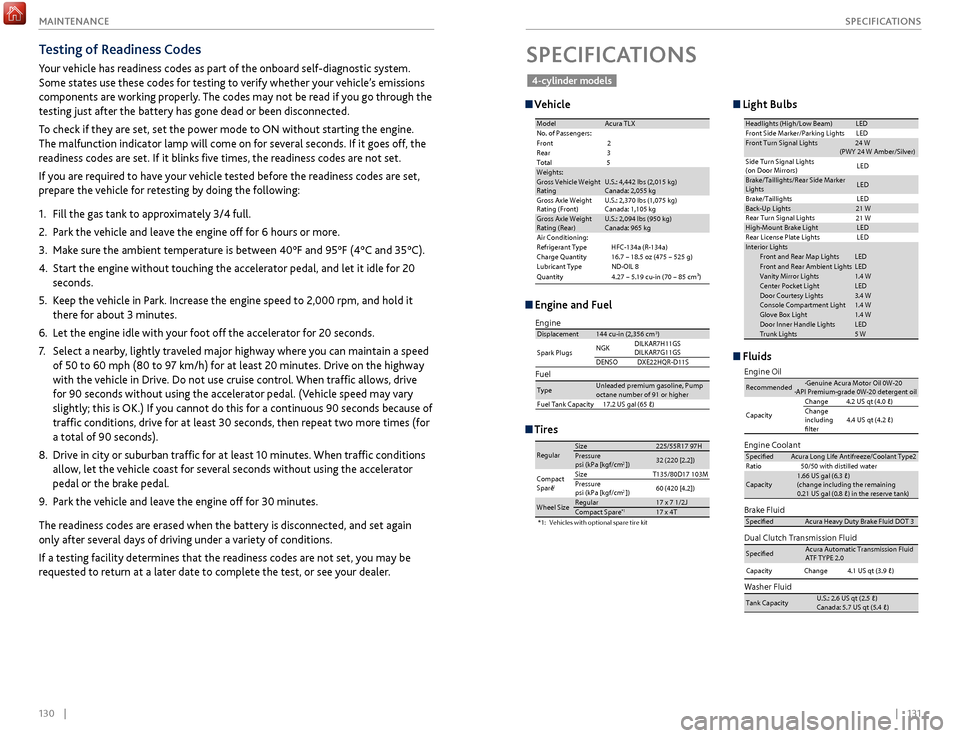
130 || 131
S PECIFICATIONS
MAINTENANCE
Vehicle
Engine and Fuel
Light Bulbs
Fluids
SPECIFICATIONS
Tires
ModelAcura TLX
No. of Passengers:
Front 2
Rear 3
Tota l5
Weights :Gross Vehicle Weight
Rating U.S.: 4,442 lbs (2,015 kg )
Canada: 2,055 kg
Gross Axle Weight
Rating (Front)U.S.: 2,370 lbs (1,075 kg )
Canada: 1,105 kg
Gross Axle Weight
Rating (Rear )U.S.: 2,094 lbs (950 kg )
Canada: 965 kg
Air Conditioning:
Refrigerant Type HFC-134a (R-134a)
Charge Quantity 16.7 – 18.5 oz (475 – 525 g)
Lubricant Type ND-OIL 8
Quantity 4.27 – 5.19 cu-in (70 – 85 cm�)
Headlights (High/Low Beam )LED
Front Side Marker/Parking Lights LED
Front Turn Signal Lights 24 W
(PWY 24 W Amber/Silver)
Side Turn Signal Lights
(on Door Mirrors) LE
D
Brake/Taillights/Rear Side Marker
Lights LE
D
Brake/Taillights
Back-Up Lights21 W
Rear Turn Signal Lights
High-M ount Brake Ligh tLED
Rear License Plate Lights
In terior Light sFront and Rear Map LightsLEDFront and Rear Ambient Light sLEDVanity Mirror Lights1.4 WCenter Pocket LightLEDDoor Courtesy Lights3.4 WConsole Compartment Ligh t1.4 WGlove Box Ligh t1.4 WDoor Inner Handle LightsLEDTrunk Lights5 W
LE D
LE D
21
W
Brake Fluid
Dual Clutch Transmission Fluid
SpecifedAcura Heavy Duty B\krake \fluid DOT \b
SpecifedAcura Automatic Tra\knsmission \fluid
AT\f TYPE 2.0
Engine Oi l
Engine Coolan
t
Recommended·Genuine Acura Mot\kor Oil 0W-2 0
·API Premium-grade\k 0W-20 detergent oi\k l
Capacity Change 4.2 US qt (4.0 �)
Change
including
flter
4.4 US qt (4.2 �
)
SpecifedAcura Long Life An\ktifreeze/Coolant Ty\kpe2
Ratio 50/50 with distill\ked water
Capacity \k Change \k 4.1 US\k qt (\b.9 �)
Capacity
1.66 US gal (6.\b �)\k
(change including \kthe remaining
0.21 US gal (0.8 �)\k in the reserve ta\knk)
Washer Fluid
Tank Capacit yU.S.: 2.6 US qt (2.5\k �)
Canada: 5.7 US qt \k(5.4 � )
Fuel
Displacement144 cu-in (2,356 cm3)
Spark Plugs NG
K DILKAR7H11GS
DILKAR7G11GS
DENSO DXE22HQR-D11 S
TypeUnleaded premium gasoline, Pump
octane number of 91 or higher
Fuel Tank Capacity 17.2 US gal (65 �)
Engine
*1: Vehicles with optional spare tire kit
RegularSize225/55R 17 97HPressure
psi (kPa [kgf/cm2])32 (220 [2.2])
Compact
Spar e*1SizeT135/80D17 103M
Pressure
psi (kPa [kgf/cm
2]) 60
(420 [4.2])
Wheel SizeRegular17 x 7 1/2 JCompact Spar e*117 x 4T
4-cylinder models
Testing of Readiness Codes
Your vehicle has readiness codes as part of the onboard self-diagnostic system.
Some states use these codes for testing to verify whether your vehicle’s emissions
components are working properly. The codes may not be read if you go through the
testing just after the battery has gone dead or been disconnected.
To check if they are set, set the power mode to ON without starting the engine.
The malfunction indicator lamp will come on for several seconds. If it goes off, the
readiness codes are set. If it blinks five times, the readiness codes are not set.
If you are required to have your vehicle tested before the readiness codes are set,
prepare the vehicle for retesting by doing the following:
1.
Fill the
gas tank to approximately 3/4 full.
2.
P
ark the vehicle and leave the engine off for 6 hours or more.
3.
Mak
e sure the ambient temperature is between 40°F and 95°F (4°C and 35°C).
4.
Start
the engine without touching the accelerator pedal, and let it idle for 20
seconds.
5.
K
eep the vehicle in Park. Increase the engine speed to 2,000 rpm, and hold it
there for about 3 minutes.
6.
Let
the engine idle with your foot off the accelerator for 20 seconds.
7.
Select a nearb
y, lightly traveled major highway where you can maintain a speed
of 50 to 60 mph (80 to 97 km/h) for at least 20 minutes. Drive on the highway
with the vehicle in Drive. Do not use cruise control. When traffic allows, drive
for 90 seconds without using the accelerator pedal. (Vehicle speed may vary
slightly; this is OK.) If you cannot do this for a continuous 90 seconds because of
traffic conditions, drive for at least 30 seconds, then repeat two more times (for
a total of 90 seconds).
8.
Driv
e in city or suburban traffic for at least 10 minutes. When traffic conditions
allow, let the vehicle coast for several seconds without using the accelerator
pedal or the brake pedal.
9.
P
ark the vehicle and leave the engine off for 30 minutes.
The readiness codes are erased when the battery is disconnected, and set again
only after several days of driving under a variety of conditions.
If a testing facility determines that the readiness codes are not set, you may be
requested to return at a later date to complete the test, or see your dealer.
Page 74 of 75
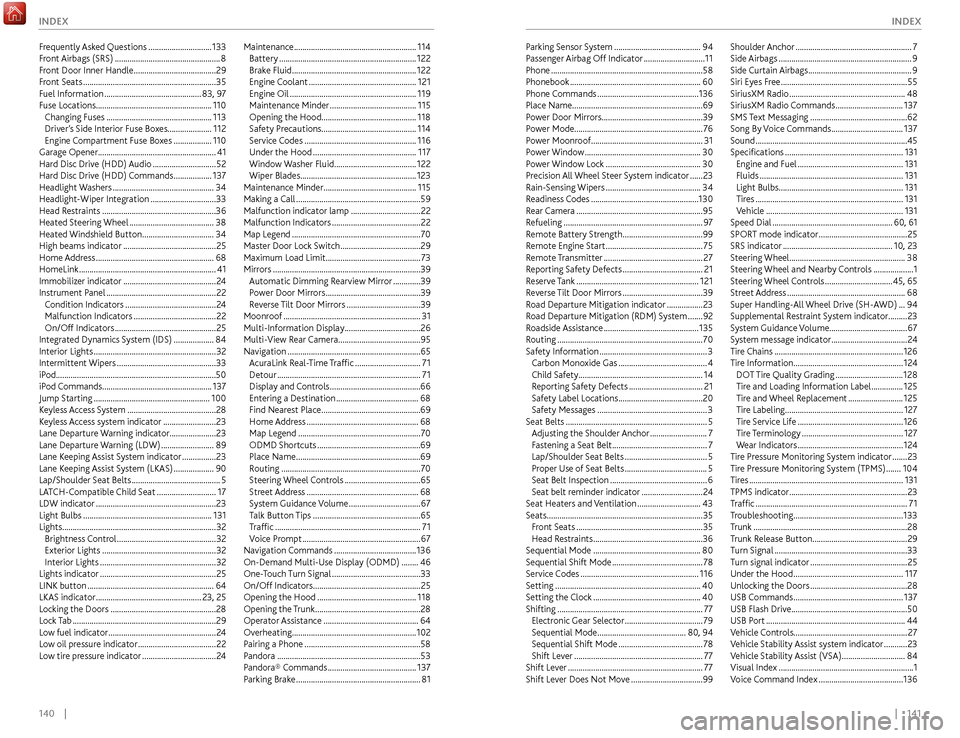
140 || 141
INDEX
INDEX
Parking Sensor System ......................................... 94
P assenger Airbag Off Indicator .............................11
Phone
........................................................................\
58
Phonebook
.............................................................. 60
Phone Commands
................................................ 136
Place Name..............................................................69
Power Door Mirrors................................................39
Power Mode............................................................. 76
Power Moonroof
..................................................... 31
Power Window
....................................................... 30
Power Window Lock
............................................. 30
Precision All Wheel Steer System indicator
......23
Rain-Sensing Wipers
............................................. 34
Readiness Codes
...................................................130
Rear Camera
............................................................ 95
Refueling
.................................................................. 97
Remote Battery Strength
......................................99
Remote Engine Start
.............................................. 75
Remote Transmitter
............................................... 27
Reporting Safety Defects
......................................21
Reserve Tank
.......................................................... 121
Reverse Tilt Door Mirrors
......................................39
Road Departure Mitigation indicator
.................23
Road Departure Mitigation (RDM) System
.......92
Roadside Assistance
............................................. 135
Routing
..................................................................... 70
Safety Information
................................................... 3
Carbon Monoxide Gas
..........................................4
Child Safety ........................................................... 14
Reporting Safety Defects
...................................21
Safety Label Locations
........................................20
Safety Messages
.................................................... 3
Seat Belts
................................................................... 5
Adjusting the Shoulder Anchor
...........................7
Fastening a Seat Belt
............................................. 7
Lap/Shoulder Seat Belts
.......................................5
Proper Use of Seat Belts
.......................................5
Seat Belt Inspection
.............................................. 6
Seat belt reminder indicator
.............................24
Seat Heaters and
Ventilation
..............................43
Seats
........................................................................\
.. 35
Front Seats
............................................................ 35
Head Restraints
.................................................... 36
Sequential Mode
................................................... 80
Sequential Shift Mode
........................................... 78
Service Codes
........................................................ 116
Setting
..................................................................... 40
Setting the Clock
................................................... 40
Shifting
..................................................................... 77
Electronic Gear Selector
.....................................79
Sequential Mode
.......................................... 80, 94
Sequential Shift Mode
........................................78
Shift Lever
............................................................. 77
Shift Lever
................................................................ 77
Shift Lever Does Not Move
..................................99Shoulder Anchor
.......................................................7
Side Airbags ...............................................................9
Side Curtain Airbags
.................................................9
Siri Eyes Free
............................................................55
SiriusXM Radio
.......................................................48
SiriusXM Radio Commands
................................1
37
SMS Text Messaging
..............................................62
Song By Voice Commands
..................................1
37
Sound
........................................................................\
45
Specifications
........................................................131
Engine and Fuel
..................................................131
Fluids
....................................................................131
Light Bulbs........................................................... 131
Tires
......................................................................131
Vehicle
.................................................................131
Speed Dial
.........................................................60, 61
SPORT mode indicator
..........................................25
SRS indicator
....................................................10, 23
Steering Wheel ....................................................... 38
Steering Wheel and Nearby Controls
...................1
Steering Wheel Controls
................................45
, 65
Street Address
........................................................68
Super Handling-All Wheel Drive (SH-AWD)
...94
Supplemental Restraint System indicator.........23
System Guidance Volume ..................................... 67
System message indicator
....................................24
Tire Chains
.............................................................126
Tire Information
....................................................124
DOT Tire Quality Grading
................................128
Tir
e and Loading Information Label ...............125
Tire and Wheel Replacement
..........................125
Tire Labeling........................................................ 127
Tire Service Life
..................................................126
Tire Terminology
................................................127
Wear Indicators
..................................................124
Tire Pressure Monitoring System indicator
.......23
Tire Pressure Monitoring System (TPMS)
.......104
Tires
........................................................................\
.131
TPMS indicator
........................................................23
Traffic
........................................................................\
71
Troubleshooting
....................................................133
Trunk
........................................................................\
.28
Trunk Release Button
.............................................29
Turn Signal
...............................................................33
Turn signal indicator
..............................................25
Under the Hood
....................................................117
Unlocking the Doors
..............................................28
USB Commands
....................................................137
USB Flash Drive
.......................................................50
USB Port
..................................................................44
Vehicle Controls ...................................................... 27
Vehicle Stability Assist system indicator
...........23
Vehicle Stability Assist (VSA)
..............................84
Visual Index
................................................................1
Voice Command Index
........................................136
Frequently Asked Questions
.............................. 133
F
ront Airbags (SRS)
.................................................. 8
Front Door Inner Handle
....................................... 29
Front Seats
............................................................... 35
Fuel Information
.............................................. 83, 97
Fuse Locations
....................................................... 110
Changing Fuses
.................................................. 113
Driver’s Side Interior Fuse Boxes..................... 112
Engine Compartment Fuse Boxes
.................. 110
Garage Opener ........................................................ 41
Hard Disc Drive (HDD) Audio
.............................. 52
Har
d Disc Drive (HDD) Commands
.................. 137
Headlight Washers
................................................ 34
Headlight-Wiper Integration
............................... 33
Head R
estraints
...................................................... 36
Heated Steering Wheel
........................................ 38
Heated Windshield
Button
.................................. 34
High beams indicator
............................................ 25
Home Address
........................................................ 68
HomeLink
................................................................. 41
Immobilizer indicator
............................................ 24
Instrument P anel .................................................... 22
Condition Indicators
........................................... 24
Malfunction Indicators
.......................................22
On/Off Indicators
................................................ 25
Integrated Dynamics System (IDS)
...................84
Interior Lights
.......................................................... 32
Intermittent Wipers
............................................... 33
iPod........................................................................\
....50
iPod Commands
.................................................... 137
Jump Starting
....................................................... 100
Keyless Access System
.......................................... 28
K
eyless Access system indicator .........................23
Lane Departure Warning indicator......................23
Lane Departure Warning (LDW)
.........................89
Lane Keeping Assist System indicator
................23
Lane Keeping Assist System (LKAS)
...................90
Lap/Shoulder Seat Belts
..........................................5
LATCH-Compatible Child Seat
............................17
LDW indicator
......................................................... 23
Light Bulbs
............................................................. 131
Lights
........................................................................\
. 32
Brightness Control
............................................... 32
Exterior Lights
...................................................... 32
Interior Lights
....................................................... 32
Lights indicator
....................................................... 25
LINK button
............................................................ 64
LKAS indicator
.................................................. 23, 25
Locking the Doors
.................................................. 28
Lock Tab
.................................................................... 29
Low fuel indicator
................................................... 24
Low oil pressure indicator
.....................................22
Low tire pressure indicator
...................................24Maintenance
..........................................................
114
Battery .................................................................
122
Brake Fluid ...........................................................
122
Engine Coolant ...................................................
121
Engine Oil ............................................................
119
Maintenance Minder .........................................
115
Opening the Hood ............................................. 118
Safety Precautions............................................. 114 Service Codes .....................................................
116
Under the Hood .................................................
117
Window Washer Fluid
.......................................
122
Wiper Blades
.......................................................
123
Maintenance Minder ............................................
115
Making a Call ...........................................................
59
Malfunction indicator lamp
.................................
22
Malfunction Indicators
..........................................
22
Map Legend .............................................................
70
Master Door Lock Switch ......................................
29
Maximum Load Limit .............................................
73
Mirrors ......................................................................
39
Automatic Dimming Rearview Mirror .............39
Power Door Mirrors .............................................39
Reverse Tilt Door Mirrors
...................................39
Moonroof
.................................................................31
Multi-Information Display
....................................26
Multi-View Rear Camera
.......................................95
Navigation
...............................................................65
AcuraLink Real-Time Traffic
...............................71
Detour
....................................................................71
Display and Controls
...........................................66
Entering a Destination
.......................................68
Find Nearest Place
...............................................69
Home Address
.....................................................68
Map Legend
..........................................................70
ODMD Shortcuts
.................................................69
Place Name
...........................................................69
Routing
..................................................................70
Steering Wheel Controls
....................................65
Str
eet Address .....................................................68
System Guidance Volume
..................................67
T
alk Button Tips ...................................................65
Traffic
.....................................................................71
Voice Prompt
........................................................67
Navigation Commands
.......................................136
On-Demand Multi-Use Display (ODMD)
........46
One-Touch Turn Signal
..........................................33
On/Off Indicators
...................................................25
Opening the Hood
...............................................118
Opening the Trunk
..................................................28
Operator Assistance
.............................................64
Overheating
...........................................................102
Pairing a Phone
.......................................................58
Pandora
....................................................................53
Pandora® Commands
..........................................137
Parking Brake
...........................................................81